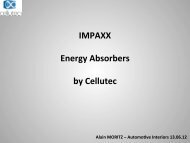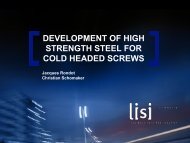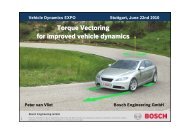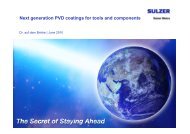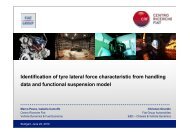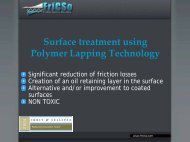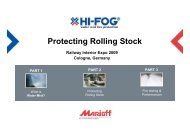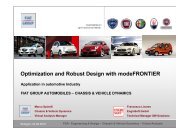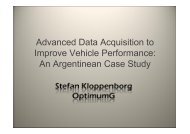Day 1 - 12 Sven Hersel - Ukintpress-conferences.com
Day 1 - 12 Sven Hersel - Ukintpress-conferences.com
Day 1 - 12 Sven Hersel - Ukintpress-conferences.com
Create successful ePaper yourself
Turn your PDF publications into a flip-book with our unique Google optimized e-Paper software.
Development Of Water-Cooled Exhaust Turbo<br />
Chargers<br />
Dr. <strong>Sven</strong> Hensel, ACTech GmbH Freiberg, Projektleiter Engineering/Simulation<br />
Holm Puder, ACTech GmbH Freiberg, Teamleiter CAE<br />
<strong>Sven</strong> Krumbiegel, ACTech GmbH Freiberg, Konstrukteur CAD<br />
Sebastian Reichl, Hochschule Anhalt (FH), M. Eng<br />
Dr. Uwe Getzlaff, ACTech GmbH Freiberg, Engineering – Consultant<br />
Engine Expo 2010 'Open Technology Forum‘<br />
• 22nd - 24th June 2010<br />
• Stuttgart Messe
Contents<br />
• initial stat and goal<br />
• technological constraints<br />
• modeling and CFD<br />
• optimization of the water jacket<br />
• <strong>com</strong>parison of turbine housings made of aluminum<br />
und ductile iron<br />
• summary and prospects
initial stat and goal<br />
• initial stat<br />
• goal<br />
– exhaust-gas turbocharger (TC) is balanced with the engine<br />
– the geometry of flow is well designed (diffuser, scroll,<br />
turbine wheel und bypass valve)<br />
– design of the water jacked<br />
– design the flow to prevent formation of vapor gas layers<br />
(Leidenfrost effect)
• initial model<br />
modeling and CFD
technological constraints<br />
two possibilities:<br />
• The water jacket core has an opening large enough<br />
that the volute core passes through.<br />
• The water jacket core is made of parts that the<br />
volute core can placed between the jacket core parts.
modeling and CFD (1D)<br />
• same surface<br />
• same volume<br />
• same wall thickness<br />
• same flow velocity<br />
as 3D design
modeling and CFD 3D<br />
• character of fluid = f(temperature)<br />
• temperature = f(flow)<br />
• flow = f(character of fluid)<br />
=> transient calculation necessary
optimization of the water jacket<br />
• first step: water jacket with uniform thickness<br />
• hot spots<br />
– high exhaust gas flow velocity<br />
– double sided exposure by hot exhaust gas
optimization of the water jacket<br />
• customize the thickness of the water jacket to uniformize the<br />
flow velocity<br />
• eliminate all deepenings with low flow velocity<br />
• direct the coolant flow round the bypass flap shaft to prevent<br />
turbulences
<strong>com</strong>parison of turbine housings<br />
made of aluminum und ductile iron<br />
• water cooled aluminum turbine housing<br />
– only slightly heavier than the <strong>com</strong>mon air cooled ductile iron<br />
turbine housing<br />
– essentially lower manufacturing costs <strong>com</strong>pared to a water<br />
cooled ductile iron turbine housing
summary and prospects<br />
The importance of water-cooled exhaust turbo chargers will<br />
rapidly increase in the next few years. The reasons are:<br />
•Turbo chargers are one of the key <strong>com</strong>ponents for reducing<br />
fuel consumption.<br />
•The water cooling enables considerable higher exhaust gas<br />
temperatures. Thus provides higher efficiency.<br />
•The water cooling makes exhaust turbo chargers suitable in<br />
indoor premises, important for mini cogeneration units for family<br />
homes and apartment buildings and important for shipbuilding.<br />
The paper presents the development of a water-cooled exhaust<br />
turbo chargers including thermal and CFD-simulation. The<br />
alternatives iron and aluminum turbo charger are <strong>com</strong>pared.





